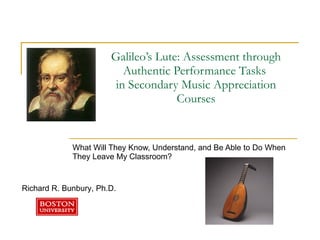
Galileos Lute Authentic Assessment
- 1. Galileo’s Lute: Assessment through Authentic Performance Tasks in Secondary Music Appreciation Courses What Will They Know, Understand, and Be Able to Do When They Leave My Classroom? Richard R. Bunbury, Ph.D.
- 2. Gallileo Gallilei, Marcus Vitruvius and Leonardo da Vinci persist as models of humanistic ideals by virtue of their forward-thinking creativity in art and science that that spill over far beyond any discrete discipline. Can schools be a fertile ground for “growing” such minds through conventional teaching? The constellation of creative skills needed for the complexities of the 21st-century environments can best be approached by imagining the tools students will possess at the end of the course, rather than by defining courses by content. Key to the process is creating student tasks that authentically teach and assess fundamental understandings .
- 5. Teaching Music of the Western Canon Matrix: Constructing Meaning Religious/ Philosophical Cultural Norms Self & Society Politics/ Governance Economic Forces Musical style/ Aesthetics
- 12. A Contiunuum Assessment Instruction Curriculum
- 15. Sample of a Unit from a Secondary Curriculum “ Connections: Humanity and Music” Christine Jones, BU MM ‘08